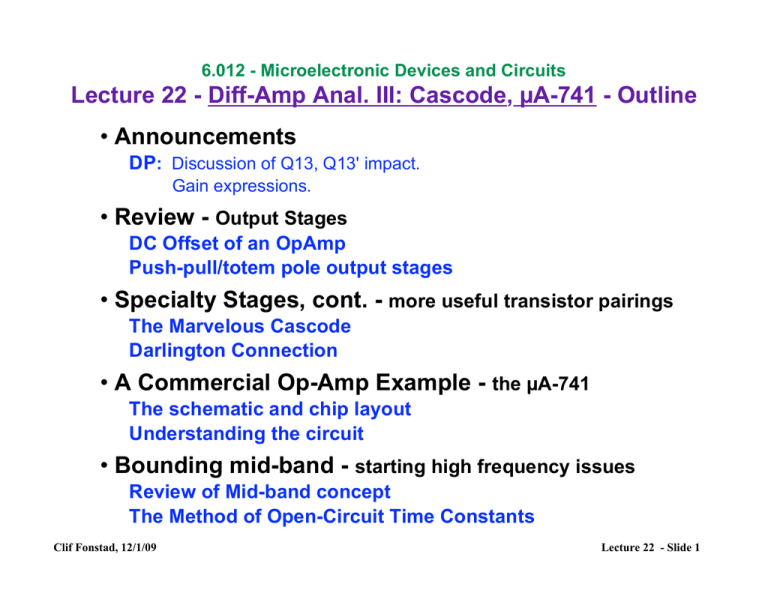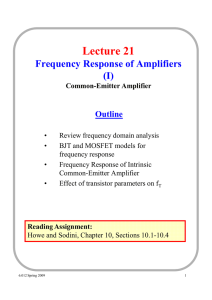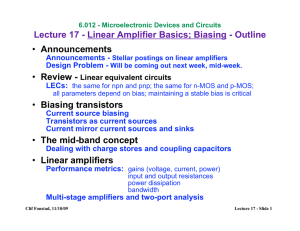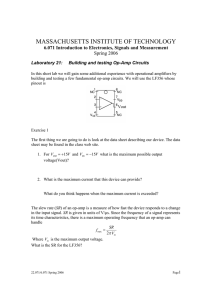
6.012 - Microelectronic Devices and Circuits
Lecture 22 - Diff-Amp Anal. III: Cascode, µA-741 - Outline
• Announcements
DP: Discussion of Q13, Q13' impact.
Gain expressions.
• Review - Output Stages
DC Offset of an OpAmp
Push-pull/totem pole output stages
• Specialty Stages, cont. - more useful transistor pairings
The Marvelous Cascode
Darlington Connection
• A Commercial Op-Amp Example - the µA-741
The schematic and chip layout
Understanding the circuit
• Bounding mid-band - starting high frequency issues
Review of Mid-band concept
The Method of Open-Circuit Time Constants
Clif Fonstad, 12/1/09
Lecture 22 - Slide 1
DC off-set at the output of an Operational Amplifier:
DC off-set:
The node between Q12 and Q13 is a high impedance node whose
quiescent voltage can only be determined by invoking symmetry.*
The voltage symmetry
says will be at this node.
+ 1.5 V
The voltage on these
two nodes is equal if
there is no input, i.e.
vIN1 = vIN2 = 0, and if
the circuit is truly
symmetrical/matched.
Q12
Q11
Q16
≈ - 0.4 V
≈ - 0.4 V ≈ 0 V
+
≈ 0.6 V
This is the high
impedance node.
Real-world asymmetries
mean the voltage on this
node is unpredictable.
Q13'
Q13
+
≈ 0.5 V
-
Q14
The voltage we need at this
node to make VOUT = 0.
A
Q15
≈ 0.6 V
-
+
≈ 0.6 V
+
Q17
+
≈ 0.6 V
Q18
-
≈ 0.6 V
-
Q20
+
Q21
0V
+
vOUT
-
B
Q19
- 1.5 V
In any practical Op Amp, a very small differential input, vIN1-vIN2,
is require to make the voltage on this node (and VOUT) zero.
Clif Fonstad, 12/1/09
Lecture 22 - Slide 2
DC off-set at the output of an Op Amp, cont:
V OUT
DC off-set:
The transfer characteristic,
vOUT vs (vIN1 - vIN2), will not in
general go through the origin,
i.e.,
vOUT = Avd(vIN1 - vIN2) + VOFFSET
1V
-A vd = 2x10
6
V IN2 - V IN1
0.5µV
In the example in the figure
Avd is -2 x 106, and VOFFSET is
0.1 V.
V OUT
-50nV
0.1V
V IN2 - V IN1
R
R
+
vIN
-
Input 1
-
Input 2 +
Clif Fonstad, 12/1/09
Avd
+
vOUT
-
In a practice, an Op Amp will be
used in a feed-back circuit like the
example shown to the left, and the
value of vOUT with vIN = 0 will be
50 ! quite small. For this example (in
which Avd = -2 x 106, and VOFFSET =
0.1 V) vOUT is only 0.1 µV.
In the D.P. you are asked for this value for your design.
Lecture 22 - Slide 3
Specialty pairings: Push-pull or Totem Pole Output Pairs
A source follower output:
- Using a single source follower as the output stage must be biased
with a relatively large drain current to achieve a large output voltage
swing, which in turn dissipates a lot of quiescent power.
+ 1.5 V
Load current is
supplied through
Q28 as it turns on
more strongly
vIN goes
positive
+
vIN
-
+ 1.5 V
Q28 v
goes
positive
OUT
+
IBIAS
- 1.5 V
Clif Fonstad, 12/1/09
+
vIN
-
Q
+
RL
As Q turns off
I BIAS flows
through load.
Turns off
Negative v OUT
swing limited
to -I BIAS RL
vOUT RL
-
The
Problem
vOUT
-
vIN goes
negative
IBIAS
- 1.5 V
Lecture 22 - Slide 4
Specialty Pairings: The Push-pull or Totem Pole Output
A stacked pair of complementary emitter- or source-followers
Large input resistance
Small output resistance
Voltage gain near one
Low quiescent power
V+
npn or n-MOS
follower
pnp or p-MOS
follower
Qn
+
vin+V BEn
+
vin-V EBp
-
+
vout
Qp
-
VClif Fonstad, 12/1/09
V+
+
vin+V GSn
RL
+
vin-V SGp
-
Qn
+
vout
Qp -
RL
VLecture 22 - Slide 5
Specialty pairings: Push-pull or Totem Pole in Design Prob.
Comments/Observations:
- The D.P. output stage
involves four emitter follower building blocks
arranged as two parallel
cascades of two emitter
follower stages each.
- Q20 and Q21 with
joined sources at
the output node is
called a push-pull,
or totem pole pair.
+ 1.5 V
IBIAS2
Q20
+
vIN
-
Q17
Q18
- They determine the
output resistance of
the amplifier.
- Ideally the output stage
voltage gain is ≈ 1.
Clif Fonstad, 12/1/09
+
vOUT
Q21 -
50!
IBIAS3
- 1.5 V
Lecture 22 - Slide 6
Specialty pairings: Push-pull or Totem Pole in D.P., cont.
Operation: The npn follower supplies current when the input goes
positive to push the output up, while the pnp follower sinks
current when the input goes negative to pull the output down.
+ 1.5 V
+ 1.5 V
Load current
supplied
through Q 20
IBIAS2
+
vIN
-
Q20
+
vIN
increases
vBE20
Q17
-
vBE20
increases
- 1.5 V
vOUT
increases
In
parallel
vIN
decreaes
+
vOUT
-
50!
+
vIN
-
rout ≈ rout1|| rout2
rin ≈ rin1|| rin2
Q18
vBE21
increases+
vEB21
-
IBIAS3
vOUT
decreases
+
vOUT
Q21
-
50!
Load current
drawn out
through Q 21
- 1.5 V
• The input resistance, rout, is highest about zero output, and there
it is the output resistance of the two follower stages in parallel.
• rin is lowest at this point, too, and is a parallel combination, also.
Clif Fonstad, 12/1/09
(discussed in Lecture 21)
Lecture 22 - Slide 7
Specialty pairings: Push-pull or Totem Pole, cont.
Voltage gain:
- The design problem uses a bipolar totem pole. The gain and linearity
of this stage depend on the bias level of the totem pole. The gain is
higher for with higher bias, but the power dissipation is also.
+ 1.5 V
To calculate the large signal transfer characteristic
of the bipolar totem pole we begin with vOUT:
vOUT = RL ("iE 20 " iE 21 )
The emitter currents depend on (vIN - vOUT):
+
vin+V BE20
+
iE 20 = "IE 20e( v IN "vOUT ) Vt , iE 21 = IE 21e"( v IN "vOUT ) Vt
!
Q20
+
vout
Q21 -
50!
!
Clif Fonstad, 12/1/09
(
v out = RL IE 20 e( v in "v out ) Vt " e"( v in "v out ) Vt
= 2 RL IE 20 sinh (v in " v out ) Vt
vin-V EB21
- 1.5 V
Putting this all together, and using IE21 = - IE20, we
have:
!
)
We can do a spread-sheet solution by picking a
set of values for (vIN - vOUT), using the last
equation to calculate the vOUT, using this vOUT
to calculate vIN, and finally plotting vOUT vs
vIN. The results are seen on the next slide.
Lecture 22 - Slide 8
Voltage gain, cont.:
- With a 50 Ω load and for several different bias levels we find:
The gain and linearity are
improved by increasing
the bias current, but the
cost is increased power
dissipation.
The Av is lowest and rout is highest at the
bias point (i.e., VIN = VOUT = 0). rin to
the stage is also lowest there.
Clif Fonstad, 12/1/09
Lecture 22 - Slide 9
+ 1.5 V
Specialty pairings: Push-pull or
Totem Pole in D.P., cont.
rt
Q25
+
vt
-
Reviewing the voltage gain
of an emitter follower:
+
vout
-
IBIAS
rl
iin = i b
+
- 1.5 V
r!
vin
roBias
-
"ib
ro
+
rl vout = A v vin
-
v out = (" + 1)ib ( rl || ro || rBias )
v in = ib r# + (" + 1)ib ( rl || ro || rBias )
Av =
v out
(" + 1)( rl || ro || rBias )
=
v in r# + (" + 1)( rl || ro || rBias )
$
(" + 1)rl
r# + (" + 1) rl
Note:
- The voltage gains of the third-stage emitter followers (Q25 and Q26) will likely
be very close to one, but that of the stage-four followers might be noticeably
less than one.
Clif Fonstad, 12/1/09
!
Lecture 22 - Slide 10
Specialty Pairings: The Cascode
Common-source stage followed by a common gate stage
V+
Large output resistance
Good high frequency
performance
Common Gate
CO
+
V GG
External
Load
vout
-
Common Source
+
vin
IBIAS
CE
V-
Clif Fonstad, 12/1/09
Lecture 22 - Slide 11
Specialty Pairings: The Cascode, cont.
Two-Port Analysis
rt
iin
+
+
v in
vt
Gi,cs
Gm,cs v in
-
iout
Gi,cg
Go,cs
Common Source
A i,cg iin
Go,cg
+
v out
gel
-
Common Gate
Gi,cs = 0, Gm,cs = "gm,Qcs , Go,cs = go,Qcs
Gi,cg = gm,Qcg , Ai,cg = 1, Go,cg " go,Qcs
Cascode two-port:
rt
+
vt
-
iout
iin
+
v in
Gi,CC
-!
Gm,CC v in Go,CC
+
v out
Gi,CC = 0, Gm,CC " #gm,Qcs , Go,CC " go,Qcs
Clif Fonstad, 12/1/09
gm,Qcg
gel
-
Cascode
Same Gi and Gm of CS stage, with
the very much larger Go of CG.
go,Qcg
go,Qcg
gm,Qcg
Lecture 22 - Slide 12
Specialty Pairings: The Cascode, cont.
Cascode two-port:
rt
+
v in
+
vt
-
iout
iin
-
Gi,CC
Gm,CC v in Go,CC
+
v out
gel
-
Cascode
Gi,CC = 0, Gm,CC " #gm,Qcs , Go,CC " go,Qcs
!
go,Qcg
gm,Qcg
The equivalent Cascode transistor:
The cascode two-port is that of a single MOSFET with the gm of the
first transistor, and the output conductance of common gate.
G
D
g
QCC
+
v gs
S
Clif Fonstad, 12/1/09
d
gmQ v gs
cs
s,b
goQ
cs
+
v ds
goQ /gmQ
cg
cg
s,b
Lecture 22 - Slide 13
Specialty Pairings: The Cascode, cont.
Cascode current mirrors: alternative connections
Large differential output resistance
Enhanced swing cascode
+ 1.5 V
Q1
Q2
Q3
Q4
+ 1.5 V
Classic Q
1
cascode
Q2
Q3
Q4
+ 1.5 V
V REF2
Q5
+
vIN1
-
+
Q6
Wilson
Q1
cascode
Q2
Q3
Q4
Q7
V REF1
- 1.5 V
Clif Fonstad, 12/1/09
+
vIN2
-
RL
+
vOUT
-
The output resistances and load characteristics are identical,
but the Wilson load is balanced better in bipolar applications,
and the enhanced swing cascode has the largest output
voltage swing of any of them.
Lecture 22 - Slide 14
Specialty pairings: Cascodes in a DP-like amplifier
Comments/Observations:
+ 1.5 V
Q1
This stage is essentially a
normal source-coupled
pair with a current mirror
load, but there are
differences..
Q2
V REF1
Q3
Q4
Q6
Q5
+
vOUT
-
V REF2
+
Q7
Q8
vIN1
-
vIN2
- 1.5 V
Clif Fonstad, 12/1/09
+
The first difference is that
two driver transistors are
cascode pairs.
The second difference is
that the current mirror
load is also cascoded.
The third difference is that
the stage is not biased
with a current source, but
is instead biased by the
first gain stage.
Lecture 22 - Slide 15
Specialty pairings: Cascodes in a DP-like amplifier, cont.
+ 1.5 V
+ 1.5 V
Q1
QCC1
Q2
=
V REF1
Q3
+
vOUT
-
Q4
Q6
Q5
+
vOUT
-
V REF2
+
QCC2
Q7
Q8
vIN1
-
+
QCC1 = Q1/Q3
QCC2 = Q2/Q4
QCC3 = Q7/Q5
QCC4 = Q8/Q6
Common sources
Clif Fonstad, 12/1/09
QCC3
+
vIN2
-
- 1.5 V
vIN2
- 1.5 V
+
vIN1
-
QCC4
Common
gates
g m,CC
Q CC1
gm1
Q CC2
gm 2
Q CC3
gm 7
Q CC4
gm 8
g o,CC
go1go3
gm 3
go2 go4
gm 4
go7 go5
gm 5
go8 go6
gm 6
Lecture 22 - Slide 16
Specialty pairings: The Cascode, cont.
The Folded Cascode: another variation
+ 1.5 V
Q1
Q2
Q3
Q4
Q5
Q6
Q8
Q7
A
B
Q9
B
Q10
- 1.5 V
Clif Fonstad, 12/1/09
Lecture 22 - Slide 17
Specialty pairings: The Darlington Connnection
A bipolar pair stage used to get a large input resistance
V+
Input resistance
L
O
A
D
rin = 2" r# 2 = 2 " 2 gm 2
gload
+
Output resistance
rout = 1 (1.5go2 + gload + gin )
Voltage gain
v
gm17
A v $ out = %
v in
2(1.5go2 + gload + gin )
gin
vout
+
vin
-
Q1
Q2
IBIAS
V-
!
Clif Fonstad, 12/1/09
Lecture 22 - Slide 18
Multi-stage amplifier analysis and design: The µA741
The circuit: a full schematic
Clif Fonstad, 12/1/09
Lecture 22 - Slide 19
© Source unknown. All rights reserved. This content is excluded from our Creative Commons license.
For more information, see http://ocw.mit.edu/fairuse.
Multi-stage amplifier analysis and design: The µA741
Figuring the circuit out:
Emitter-follower/
common-base "cascode"
differential gain stage
EF
CB
The full schematic
Push-pull
output
Current mirror load
Darlington common-
emitter gain stage
Clif Fonstad, 12/1/09
Simplified schematic
Another interesting discussion of the µA741:
http://en.wikipedia.org/wiki/Operational_amplifier
Lecture 22 - Slide 20
© Source unknown. All rights reserved. This content is excluded from our Creative Commons license.
For more information, see http://ocw.mit.edu/fairuse.
Multi-stage amplifier analysis and design: The µA741
The chip: a bipolar IC
Capacitor
Resistors
Transistors
Bonding pads
Clif Fonstad, 12/1/09
Lecture 22 - Slide 21
© Source unknown. All rights reserved. This content is excluded from our Creative Commons license.
For more information, see http://ocw.mit.edu/fairuse.
Mid-band, cont: The mid-band range of frequencies
In this range of frequencies the gain is a constant, and the
phase shift between the input and output is also constant
(either 0˚ or 180˚).
log |A
vd |
Mid-band Range
!LO
!b
!a !d
!c
!LO *
!HI * !HI
!4
log !
!5 !2!1 !3
All of the parasitic and intrinsic device capacitances
are effectively open circuits
All of the biasing and coupling capacitors are
effectively short circuits
Clif Fonstad, 12/1/09
Lecture 22 - Slide 23
Bounding mid-band: frequency range of constant gain and phase
Cgd
g
Common
Source
+ +
v gs
v
rt
V+
+
vt
in
-
Cgs
gmv gs
go
gsl
s,b
-
CO
+
v out
gel
CS
gob
-
LEC for common source stage with all the capacitors
vout
-
+
vin
-
CO
+
d
Biasing capacitors:
(CO, CS, etc.)
IBIAS
Device capacitors:
CE
(Cgs, Cgd, etc.)
typically in mF range
effectively shorts above ωLO
typically in pF range
effectively open until ωHI
Mid-band frequencies fall between: ωLO < ω < ωHI
V-
g
+
vt
-
rt
+
v in = v gs
s,b
d
+
gmv gs
go
v out
-
gl
s,b
Common emitter LEC for in mid-band range Note: gl = gsl + gel
What are ωLO and ωHI?
Clif Fonstad, 12/1/09
Lecture 22 - Slide 24
Estimating ωHI - Open Circuit Time Constants Method
Open circuit time constants (OCTC) recipe:
1. Pick one Cgd, Cgs, Cµ, Cπ, etc. (call it C1) and assume all others
are open circuits.
2. Find the resistance in parallel with C1 and call it R1.
3. Calculate 1/R1C1 and call it ω1.
4. Repeat this for each of the N different Cgd's, Cgs's, Cµ's, Cπ's,
etc., in the circuit finding ω1, ω2, ω3, …, ωN.
5. Define ωHI* as the inverse of the sum of the inverses of the N ω
i's:
ωHI* = [Σ(ωi)-1]-1 = [ΣRiCi]-1
6. The true ωHI is similar to, but greater than, ωHI*.
Observations:
The OCTC method gives a conservative, low estimate for ωHI.
The sum of inverses favors the smallest ωi, and thus the
capacitor with the largest RC product dominates ωHI*.
Clif Fonstad, 12/1/09
Lecture 22 - Slide 25
Estimating ωLO - Short Circuit Time Constants Method
Short circuit time constants (SCTC) recipe:
1. Pick one CO, CI, CE, etc. (call it C1) and assume all others
are short circuits.
2. Find the resistance in parallel with C1 and call it R1.
3. Calculate 1/R1C1 and call it ω1.
4. Repeat this for each of the M different CI's, CO's, CE's, CS's,
etc., in the circuit finding ω1, ω2, ω3, …, ωM.
5. Define ωLO* as the sum of the M ωj's:
ωLO* = [Σ(ωj)] = [Σ(RjCj)-1]
6. The true ωLO is similar to, but less than, ωLO*.
Observations:
The SCTC method gives a conservative, high estimate for ωLO.
The sum of inverses favors the largest ωj, and thus the
capacitor with the smallest RC product dominates ωLO*.
Clif Fonstad, 12/1/09
Lecture 22 - Slide 26
Summary of OCTC and SCTC results
log |A
vd |
Mid-band Range
!LO
!b
!a !d
!c
!LO *
!HI * !HI
!4
log !
!5 !2!1 !3
• OCTC:
1.
2.
3.
an estimate for ωHI
ωHI* is a weighted sum of ω's associated with device capacitances:
(add RC's and invert)
Smallest ω (largest RC) dominates ωHI*
Provides a lower bound on ωHI
• SCTC:
1.
2.
3.
an estimate for ωLO
ωLO* is a weighted sum of w's associated with bias capacitors:
(add ω's directly)
Largest ω (smallest RC) dominates ωLO*
Provides a upper bound on ωLO
Clif Fonstad, 12/1/09
Lecture 22 - Slide 27
6.012 - Microelectronic Devices and Circuits
Lecture 22 - Diff-Amp Analysis II - Summary
• Design Problem Issues
Q13, Q13'; voltage gains
• Specialty stages - useful pairings
Source coupled pairs: MOS
Push-pull output: Two followers in vertical chain
Very low output resistance
Shared duties for positive and negative output swings
Cascode: Common-source/emitter performance
Greatly enhanced output resistance
Find greatly enhanced high frequency performance also
Darlington: Increased input resistance ona bipolar stage
µA 741: A workhorse IC showing all of these pairs
• Bounding mid-band
Open Circuit Time Constant Method: An estimate of ωHI
Short Circuit Time Constant Method: An estimate of ωLO
Clif Fonstad, 12/1/09
Lecture 22 - Slide 28
MIT OpenCourseWare
http://ocw.mit.edu
6.012 Microelectronic Devices and Circuits
Fall 2009
For information about citing these materials or our Terms of Use, visit: http://ocw.mit.edu/terms.








